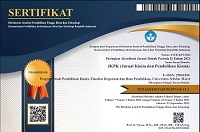
Analysis of Nitrogen Dioxide as Air Pollutant in Office, Industrial, Residential, and Transportation Areas in Lampung Province
Abstract
Monitoring air quality can be undertaken in industrial areas, residential areas, offices, and transportation hubs to maintain public health and sustainable environmental practices in Lampung Province. The province suffers unique challenges, including a mix of emission sources (industrial activities, vehicular traffic, and domestic operations). Industrial zones have high levels of nitrogen dioxide (NO₂) due to manufacturing, transportation hubs have increased NO₂ due to vehicle emissions, and residential regions provide background pollution from household pollutants. Such complex spires must be addressed to achieve acceptable levels of air quality. This research aimed to analyze NO₂ concentrations on four stations in 15 districts of Lampung Province using the Air Pollution Index Values (ISP - Indeks Standar Pencemaran Udara). To assess the coupling relationship between the NO₂ concentrations and seasonal variations over 2 years, Statistical Analysis of Variance (ANOVA) was analyzed. The results showed that NO₂ levels had higher concentrations along transportation routes but were still safe and non-hazardous according to Regulation No. 41 of 1999. The average NO₂ concentrations in the districts were also below the regulatory threshold, reflecting good air quality management in the region. The ANOVA analysis results with the Anderson-Darling test show p-values of 0.322 (rainy season) and 0.258 (dry season), both above the 0.05 significance level. These results imply that the data follows a normal distribution and that there are no significant differences between the districts' average NO₂ concentrations by season. The study highlights the necessity of continued surveillance and targeted interventions to address air quality issues in Lampung Province.
Keywords
Full Text:
PDFReferences
[1] M. Ferro et al., “A Distributed Measurement System for the Estimation of Air Quality,” IEEE Instrumentation and Measurement Magazine, vol. 23, pp 51-56, 2020. doi: 10.1109/MIM.2020.9153575.
[2] I. Manisalidis et al., “Environmental and health impacts of air pollution: a review,” Frontiers in public health, vol. 8, no. 14, pp, 1-13, 2020. doi: 10.3389/fpubh.2020.00014.
[3] A. Rehman et al., ”Sustainable development and pollution: The effects of CO2 emission on population growth, food production, economic development, and energy consumption in Pakistan,” Environmental Science and Pollution Research, vol. 12, pp 1-12, 2022. doi: 10.1007/s11356-021-16998-2.
[4] P. Saxena et al., ”Primary criteria air pollutants: environmental health effects,” Criteria air pollutants and their impact on environmental health, pp 49-82, 2019. doi: 10.1007/978-981-13-9992-3_3.
[5] E. Fazakas et al, “Health effects of air pollutant mixtures (volatile organic compounds, particulate matter, sulfur, and nitrogen oxides)–a literature review,” Reviews on Environmental Health, vol. 39, no. 3, pp 459-478, 2024. doi: 10.1515/reveh-2022-0252.
[6] M. A. Fekih, et al., “Participatory Air Quality and Urban Heat Islands Monitoring System,” IEEE Transactions on Instrumentation and Measurement, vol. 70, pp 1–14, 2020. doi: 10.1109/TIM.2020.3034987.
[7] M. M. M. F. Jion et al., ”A critical review and prospect of NO2 and SO2 pollution over Asia: Hotspots, trends, and sources,” Science of The Total Environment, vol. 876, pp 162851, 2023. doi: 10.1016/j.scitotenv.2023.162851.
[8] A. Aggarwal and D. Toshniwal, ”Detection of anomalous nitrogen dioxide (NO2) concentration in urban air of India using proximity and clustering methods,” Journal of the Air and Waste Management Association, vol. 69, no. 7, pp 805-822, 2019. doi: 10.1080/10962247.2019.1577314.
[9] A. T. Hoang et al., “An analysis and review on the global NO2 emission during lockdowns in COVID-19 period. Energy Sources,” Part A: Recovery, Utilization, and Environmental Effects, pp 1-21, 2021. doi: 10.1080/15567036.2021.1902431.
[10] A. Mainka and M. Zak (2022). Synergistic or antagonistic health effects of long-and short-term exposure to ambient NO2 and PM2.5: a review,” International Journal of Environmental Research and Public Health, vol. 19, n0. 21, pp 14079, 2022. doi: 10.3390/ijerph192114079.
[11] J. Lindén et al., “Location, location, location–A study of factors affecting air quality in Swedish preschool yards,” . Sustainable Cities and Society, vol 113, pp 105683, 2024. doi: 10.1016/j.scs.2024.105683.
[12] L. N. Qolifah et al., “Karakteristik Risiko Kesehatan Non Karsinogenik Akibat Paparan Gas SO2 dan NO2 pada Pemulung di TPA Jatibarang Kota Semarang,” Jurnal Kesehatan Lingkungan Indonesia, vol. 23, no. 1, pp. 50-58, 2023. doi: 10.14710/jkli.23.1.50-58.
[13] L. K. Widya, et al., “Comparison of Spatial Modelling Approaches on PM10 and NO2 Concentration Variations: A Case Study in Surabaya City, Indonesia,” International Journal of Environmental Research and Public Health, vol. 17, no. 23, pp. 8883, 2020. doi: 10.3390/ijerph17238883.
[14] A. Pradifan et al., “Pemantauan Kualitas Udara Kota Tegal (Studi Kasus: Kecamatan Tegal Selatan, Kecamatan Tegal Barat, Kecamatan Tegal Timur),” Jurnal Ilmu Lingkungan, vol. 19, no. 1, pp. 73-82, 2021. doi: 10.14710/jil.19.1.73-82.
[15] A. Al Yammahi and Z. Aung, “A Study of Nitrogen Dioxide (NO2) Periodicity Over the United Arab Emirates Using Wavelet Analysis,” Scientific Reports, vol. 12, no. 1, pp. 18144, 2022. doi: 10.1038/s41598-022-21937-3.
[16] J. Rovira et al., “Air Quality, Health Impacts and Burden of Disease Due to Air Pollution (PM10, PM2, NO2 and O3): Application of Air Q+ Model to the Camp de Tarragona County (Catalonia, Spain),” Science of the Total Environment, vol. 703, pp. 135-145, 2020. doi: 10.1016/j.scitotenv.2019.135538.
[17] C. Izzati et al., “Analisis Risiko Kesehatan Lingkungan Paparan Nitrogen Dioksida (NO2) Pada Penyapu Jalan di Kota Jambi Tahun 2021,” Jurnal Kesmas Jambi, vol. 5, no. 2, pp. 45-54, 2021. doi: 10.22437/jkmj.v5i2.14032.
[18] B. Prasetio and A. Mardianto, “Air Pollution Analysis of Preconstruction and Construction Phases in Sumatera Institute of Technology, South Lampung,” Journal of Multidisciplinary Academic, vol. 4, no. 2, pp. 112-115, 2020.
[19] H. Moshammer et al., “Nitrogen-Dioxide Remains a Valid Air Quality Indicator,” International Journal of Environmental Research and Public Health, vol. 17, pp. 1-11, 2020. doi: 10.3390/ijerph17103733.
[20] F. Firnanelty et al., “Comparison of Air Contact and Distilled Water Distribution Method in the Conversion of CaO to Ca(OH)2 as a Precursor Hydroxyapatite Synthesis,” JKPK (Jurnal Kimia dan Pendidikan Kimia), vol. 8, no. 3, pp. 423-434, 2023. doi: 10.20961/jkpk.v8i3.78348.
[21] D. Gusnita and N. Cholianawati., “Pollutant Concentration and Trajectory Patterns of PM2.5 Including Meteo Factors in Jakarta City,” JKPK (Jurnal Kimia dan Pendidikan Kimia), vol. 4, no. 3, pp. 152-163, 2019. doi: 10.20961/jkpk.v4i3.35028.
[22] A. R. Gintu et al., “The Determination of Metals and Minerals Contents in the Water of Pucung River, Prehistoric Site Sangiran, Central Java,” JKPK (Jurnal Kimia dan Pendidikan Kimia), vol. 4, no. 1, pp. 17-24, 2019. doi: 10.20961/jkpk.v4i1.25250.
[23] E. B. Agustina and A. H. P. Yuniarto., “Study of BOD, COD and TSS Removal in Batik Industry Wastewater Using Electrocoagulation Method,” JKPK (Jurnal Kimia dan Pendidikan Kimia), vol. 7, no. 2, pp. 150-158, 2022. doi: 10.20961/jkpk.v7i2.59977.
[24] H. Moshammer et al., “Nitrogen-Dioxide Remains a Valid Air Quality Indicator,” International Journal of Environmental Research and Public Health, vol. 17, pp. 1-11, 2020. 10.3390/ijerph17103733.
[25] SNI 7119-2:2017, Ambient Air – Part 2: Test Method for Nitrogen Dioxide (NO2) Levels Using the Griess Saltzman Method with a Spectrophotometer, Jakarta: National Standardization Agency (Badan Standardisasi Nasional - BSN).
[26] Head of the Environmental Impact Control Agency Number: KEP107/KABAPEDAL/11/1997 Regarding “Technical Guidelines for Calculation and Reporting as well as Information on Standard Air Pollution Index.”
[27] Government Regulation of the Republic of Indonesia No. 41 Year 1999 dated May 26, 1999, on Air Pollution Control, Jakarta.
[28] J. S. Swartz et al., “Twenty-One Years of Passive Sampling Monitoring of SO2, NO2 and O3 at the Cape Point GAW Station, South Africa,” Atmospheric Environment, vol. 222, pp. 117128, 2020. doi: 10.1016/j.atmosenv.2019.117128.
[29] A. Höhne et al., “Assessing the Spatial Distribution of NO2 and Influencing Factors in Urban Areas—Passive Sampling in a Citizen Science Project in Berlin, Germany,” Atmosphere, vol. 14, no. 2, pp. 360, 2023. doi: 10.3390/atmos14020360.
[30] E. Felix et al., “Passive Sampling as a Feasible Tool for Mapping and Model Evaluation of the Spatial Distribution of Nitrogen Oxides in the City of Curitiba, Brazil,” Air Quality, Atmosphere and Health, vol. 12, pp. 837-846, 2019. doi: 10.1007/s11869-019-00701-z.
[31] R. S. Pontoh et al., “Air Quality Mapping in Bandung City,” Atmosphere, vol. 14, pp. 1-15, 2023. doi: 10.3390/atmos14091444.
[32] D. Septiyana et al., “Pemantauan Kualitas Udara ISPU (PM10, SO2, NO2) Menggunakan Citra Landsat 8 dan 9 untuk Kecamatan Mijen Selama Pandemi Covid-19,” Jurnal Geodesi Undip, vol. 12, no. 3, pp. 271-280, 2023. doi: 10.14710/jgundip.2023.38859.
[33] R. M. Agus et al., “Ambient Air Quality of SO2 and NO2 in Settlements Around Industrial Area of Makassar 2019,” Enfermeria Clinica, vol. 30, pp. 328-332, 2020. doi: 10.1016/j.enfcli.2019.10.093.
[34] C. J. Chung et al., “Exposure to Ambient NO2 Increases the Risk of Dry Eye Syndrome in Females: An 11-Year Population-Based Study,” International Journal of Environmental Research and Public Health, vol. 18, no. 13, pp. 6860, 2021. doi: 10.3390/ijerph18136860.
[35] U.S. Environmental Protection Agency (EPA), “National Ambient Air Quality Standards (NAAQS),” [Online]. Available: https://www.epa.gov/criteria-air-pollutants/naaqs-table . [Accessed: Nov. 14, 2024].
Refbacks
- There are currently no refbacks.








